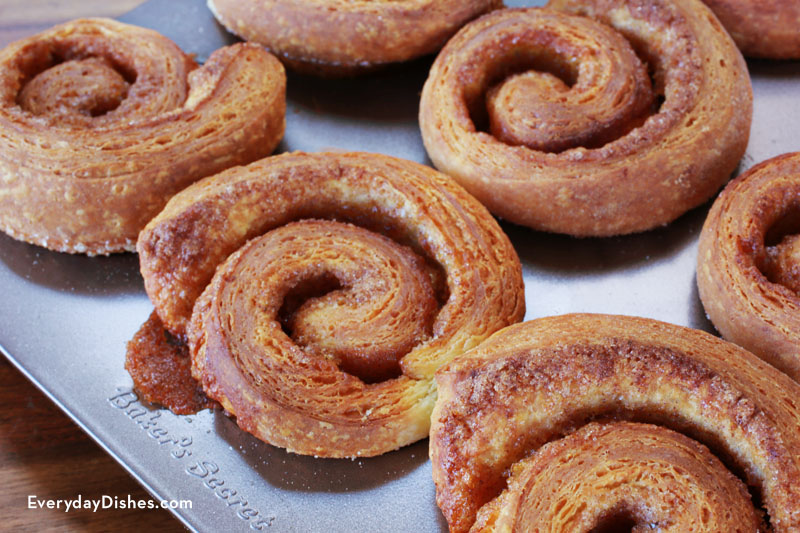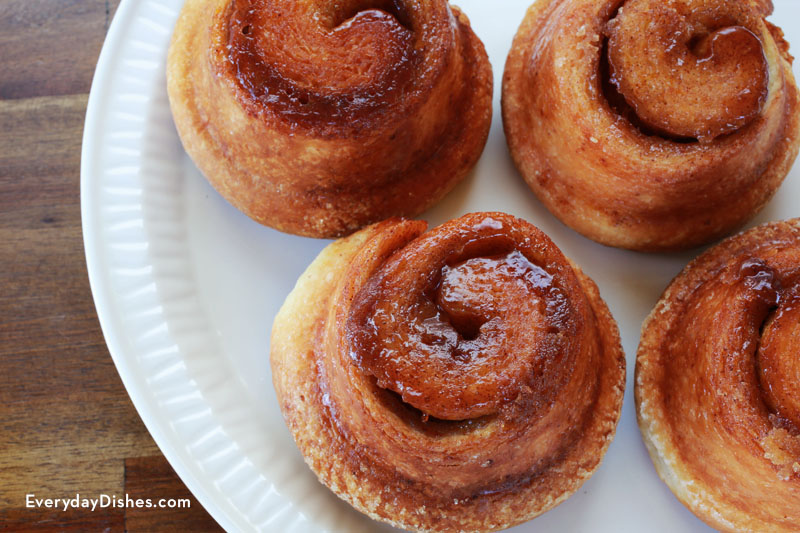Morning buns
We’ve simplified the ‘croissant’ dough method, making an achievable morning buns recipe for the everyday cook. The process will demand time and patience, but we promise these buns are totally worth it! The directions are long, but easy to follow and we’ve added lots of extra tips to ensure you’re successful.
Don’t be afraid to bake the morning buns until they’re dark brown and crispy, just like you see in the French patisseries. When we made these babies in the test kitchen everyone thought they looked burnt, but once we had a taste it was unanimously agreed that they were perfect!
With just a hint of orange essence in these decadent buns, those lucky enough to eat one will beg for more! This recipe yields eight buns—if you want to make more at one time, don’t double the recipe. Instead, make two separate batches of dough—doubling the recipe just makes the dough too much to handle.
We can’t wait for you to try these light, crispy, gooey, sweet and buttery morning buns. They’re absolutely scrumptious!

morning buns recipe
Ingredients
dough
- 1/4 cup whole milk
- 1/4 cup water
- 2 Tbsp sugar
- 1 pkg active dry yeast, or 1¼ tsp
- 2 cups bread flour
- 1/2 tsp salt
- 10 Tbsp unsalted butter, very cold and cut into ½" cubes
]filling
- 1/4 cup brown sugar
- 1/4 cup granulated sugar
- 1 orange zest of orange, finely grated
- 1 tsp ground cinnamon
- 1/4 tsp salt
- 4 Tbsp unsalted butter
- granulated sugar
Instructions
- To make the dough, stir milk, water, sugar and yeast together until yeast and sugar have completely dissolved. The temperature of the water and milk should not be too warm or too cool, about 95−110 degrees.
- Next, cut the butter into ½" cubes and place in the freezer so it gets extremely cold and firm.
- Place the flour and salt in the bowl of a food processor fitted with the metal blade. Then pulse once or twice to just mix them together.
- Take a moment to check the yeast mixture. If the mixture is bubbling and foamy, then you may proceed to the next step. If the yeast mixture is not producing bubbles, you may want to wait a little bit longer to ensure that your yeast is active. If the yeast fails to activate, you will have to try again. The process for yeast to become active should not take longer than 10 minutes, so if this step did not work, it’s likely because the water/milk temperature was too high, or your yeast is too old or has been mishandled. If this is the case, you will need to buy new yeast and start again.
- Once your yeast mixture is bubbly, remove the butter from the freezer and add it to the flour mixture in the food processor. Pulse food processor quickly until butter cubes have become the size of peas, about 3−4 quick pulses. Don’t overdo this step! Large chunks of butter are preferable to over-processing your dough!
- Transfer the flour/butter mixture into a large mixing bowl, and work quickly from this point so that the butter does not become too soft. Add yeast mixture to flour and butter then gently fold together to form dough. Your objective here is to completely moisten the dry ingredients and form a cohesive ball of dough without reducing the size of the butter chunks.
- Dust the countertop and dough ball with flour then shape the dough into a flat square using your fingers. Use a rolling pin to roll dough into a rectangle about ¼" thick, keeping the sides as straight as possible. Use flour only as needed. If the butter begins to get too soft, place the dough back into the refrigerator until it is firm again.
- Turn the dough so that the short end of the rectangle is facing you. Brush off any excess flour from the top and fold it into thirds (the same way you would fold a letter to place into an envelope).
- Roll the dough into a ¼" thick rectangle once again, turning the short side to face you, and folding it up like a letter. Wrap the dough in plastic wrap and chill for 1 hour (you have now completed two folds).
- After your dough has had a chance to rest and chill for an hour, repeat this process again twice (you will need to complete a total of four folds). When you have finished rolling and folding, chill the dough for 1 more hour.
- While the dough is chilling, you will prepare the filling.
- To make the filling, mix granulated sugar, brown sugar, orange zest, cinnamon and salt then set aside.
- Melt the butter in the microwave and allow it to cool slightly. Then brush a little bit of the melted butter inside 8 cups of a muffin tin. Sprinkle the buttered muffin tin with granulated sugar to coat, the same way you would butter and flour a cake pan. Tap to remove any excess sugar and set the muffin tin aside.
- Remove the dough from your refrigerator, lightly flour your work surface and roll the dough into a 12"x12" square. Brush the melted butter over the dough in a thin, even layer then sprinkle cinnamon-sugar mixture evenly across the entire surface pressing lightly to adhere the sugar to the butter.
- Carefully begin to roll the long side of the dough ‘jellyroll style’ until you have an 18 inch long cylinder. Make sure you are rolling the dough tightly, but don’t stretch it as you roll. Once rolled, slice into 1½" long pieces. You will have exactly 8 pieces.
- Place each piece of dough into the muffin tin. If you are baking the buns right away, cover the muffin tin with a lint-free towel and set in a warm place for 45 minutes to rise one final time (you’re almost there!). If you are making these a day ahead, cover with plastic wrap and place in the refrigerator overnight. Remove the dough from the refrigerator and allow it to sit in a warm spot for 1 hour before baking
- Preheat the oven to 350 degrees. When the buns have doubled in size, place them in the oven to bake for 18−20 minutes.
- Don’t be tempted to take them out of the oven when they are light golden brown and gooey. You are looking for dark brown, crispy, crusty, almost dry looking looking buns. They might seem overdone, but they will be perfect, you’ll see (see photo)!
- Remove the buns from the oven and immediately invert the pan onto a tray or plate to remove the buns. Allow buns to cool 5 minutes then toss in granulated sugar to coat completely.
- Serve the buns up and let the compliments start rolling in!
Notes




I wondered the same thing, and re-read several times. How did the 12×12 square become an 18 inch roll?
Is there an error in the recipe? Roll into 12×12 and then roll into an 18″ roll??